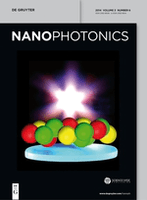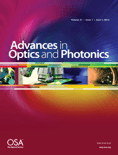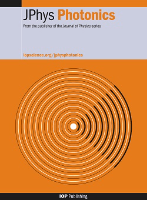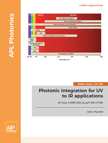
Optica
Scope & Guideline
Exploring the frontiers of optical science and materials technology.
Introduction
Aims and Scopes
- Advanced Imaging Techniques:
The journal features research on cutting-edge imaging modalities such as two-photon microscopy, ptychography, and hyperspectral imaging, highlighting advancements in resolution, speed, and depth of field. - Quantum Optics and Photonics:
A significant focus is placed on quantum phenomena in optics, including quantum key distribution, entanglement, and quantum computing, showcasing the intersection of quantum mechanics and photonics. - Metasurfaces and Nanophotonics:
Research on engineered materials, particularly metasurfaces and nanostructures, that manipulate light at the nanoscale for applications in sensing, imaging, and information processing. - Nonlinear Optics and Frequency Conversion:
The journal covers studies on nonlinear optical processes, including frequency combs, parametric amplification, and soliton dynamics, which are essential for high-speed communication and advanced laser technologies. - Optomechanics and Photonic Devices:
Investigations into the interaction between light and mechanical systems, leading to novel photonic devices and sensors, are a key theme in the journal. - Optical Materials and Fabrication Techniques:
Research on the development of new optical materials and innovative fabrication methods, including additive manufacturing and lithography, to enhance optical performance. - Light-Matter Interaction:
Papers exploring the fundamental interactions between light and matter, including studies on excitons, polaritons, and novel materials, contribute to a deeper understanding of optical phenomena.
Trending and Emerging
- Integrated Photonics and Quantum Technologies:
There is a growing interest in integrated photonic circuits that leverage quantum technologies for applications in quantum computing and secure communications, reflecting the industry's push towards miniaturization and efficiency. - Machine Learning and AI in Optics:
The integration of machine learning and artificial intelligence into optical systems for image reconstruction, data analysis, and system optimization is emerging as a significant trend, enhancing capabilities across various applications. - Biophotonics and Medical Applications:
Research focusing on the application of optical technologies in biomedicine, including imaging and sensing for diagnostics, is trending upward, driven by the demand for non-invasive techniques and real-time monitoring. - Terahertz and Mid-Infrared Technologies:
There is an increasing emphasis on terahertz and mid-infrared technologies for applications in spectroscopy, imaging, and communications, highlighting their potential in various scientific and industrial fields. - Sustainable and Green Photonics:
Emerging studies on environmentally friendly optical materials and energy-efficient photonic devices reflect the growing concern for sustainability in optics, aligning with global efforts to reduce environmental impacts. - Optical Computing and Information Processing:
The exploration of optical systems for computation, including neuromorphic computing and optical neural networks, is gaining momentum, suggesting a shift towards faster and more efficient data processing methods.
Declining or Waning
- Classical Optical Imaging Techniques:
Traditional imaging methods that do not incorporate advanced computational techniques or novel optical materials are less frequently featured, as the field shifts towards more innovative approaches like computational and multimodal imaging. - Static Optical Devices:
Research on conventional static optical devices, such as basic lenses and mirrors, has diminished as the field moves towards dynamic and tunable optical systems, including active optics and adaptive optics. - Basic Theoretical Studies:
While foundational theories remain important, there is a noticeable decrease in papers focused solely on theoretical explorations without experimental validation or practical application, as the journal emphasizes applied research. - Fiber Optics in Traditional Communication:
Publications centered on standard fiber optic communication technologies have waned, likely due to the emergence of more advanced techniques such as integrated photonics and quantum communication systems.
Similar Journals

OPTICA APPLICATA
Catalyzing Advances in Materials Science and OpticsOPTICA APPLICATA, published by Wroclaw University of Science and Technology, is a crucial platform for advancing knowledge in the fields of Atomic and Molecular Physics and Optics. With an ISSN of 0078-5466 and an E-ISSN of 1899-7015, this journal serves as a vital resource for researchers, professionals, and students seeking to explore the latest developments and applications in optical science and engineering. Although currently categorized in the fourth quartile in both Atomic and Molecular Physics and Electronic, Optical and Magnetic Materials, its commitment to publishing high-quality research articles, reviews, and technical notes remains unwavering. The journal covers diverse topics from practical applications to theoretical insights and fosters a collaborative environment for global contributors. While it does not offer an open access option, the journal is accessible through university libraries and institutional subscriptions. With an eye towards bridging academic research with real-world applications, OPTICA APPLICATA is well-positioned to influence advancements in photonics and materials science through ongoing issues from 1988 to 2024.

Advanced Photonics
Pioneering Discoveries in Photonics and BeyondAdvanced Photonics, published by SPIE-SOC PHOTO-OPTICAL INSTRUMENTATION ENGINEERS, is a prestigious open-access journal dedicated to cutting-edge research in the fields of photonics, optics, biomedical engineering, and material science. Since its inception in 2019, this journal has successfully established itself in the top quartile (Q1) of various categories, including Atomic and Molecular Physics, Biomedical Engineering, and Electronic, Optical and Magnetic Materials, showcasing its critical role in advancing knowledge and innovation within these disciplines. With impressive Scopus rankings—#8 in Biomedical Engineering, #7 in Atomic and Molecular Physics, and #10 in Materials Science—Advanced Photonics serves as an essential platform for researchers, professionals, and students alike, offering a wealth of accessible scholarly content to keep pace with rapid technological developments. The journal not only fosters collaboration and knowledge dissemination within the global scientific community but also emphasizes the importance of open access to ensure that groundbreaking research benefits society as a whole.

Nanophotonics
Fostering Collaboration in Cutting-edge NanophotonicsNanophotonics, published by WALTER DE GRUYTER GMBH, is a premier open access journal dedicated to advancing the field of nanophotonics, encompassing cutting-edge research in atomic and molecular physics, optics, biotechnology, and electronic engineering. With a significant impact factor and a notable presence in the top quartile rankings (Q1) across multiple categories, including electrical and electronic engineering, this journal serves as a critical resource for researchers and professionals aiming to explore the latest developments in the manipulation of light at the nanoscale. Since its inception in 2012, Nanophotonics has been an influential platform for disseminating innovative ideas and breakthroughs, offering unrestricted access to its content, thus fostering a collaborative environment conducive to scientific discovery. Located in Berlin, Germany, and with a commitment to promoting the highest standard of scholarly excellence, Nanophotonics continues to shape the future of optical materials and technology, inviting contributions from both established experts and emerging scholars.

JOURNAL OF RUSSIAN LASER RESEARCH
Connecting Theory and Application in Laser ResearchThe Journal of Russian Laser Research, published by Springer, stands as a vital resource for researchers and professionals in the fields of atomic and molecular physics, as well as optics and engineering. With its ISSN 1071-2836 and E-ISSN 1573-8760, this journal has been disseminating groundbreaking research since its inception in 1994, with a dedicated focus on the advancement of laser technologies and their applications. While it currently holds a Q4 classification in both Atomic and Molecular Physics and Engineering categories, its commitment to fostering novel insights and innovative methodologies positions it as a promising platform for emerging studies within these disciplines. Although the journal does not offer open access options, it continues to draw attention with a growing citation index. By publishing diverse research articles, reviews, and critical discussions, the Journal of Russian Laser Research not only enriches academic literature but also serves as a stepping stone for students and professionals seeking to deepen their understanding of laser science and its myriad applications.

Advances in Optics and Photonics
Pioneering Advances in Photonic TechnologiesAdvances in Optics and Photonics, published by the Optica Publishing Group, stands at the forefront of research dissemination in the fields of Atomic and Molecular Physics and Optics, alongside its prominence in Water Science and Technology. With an impressive Q1 ranking in both categories and a Scopus rank of #2/224, this journal boasts a 99th percentile status, underscoring its significance in the academic community. As a beacon of knowledge since its inception in 2009, the journal is dedicated to featuring cutting-edge research, innovative methodologies, and transformative applications in optics and photonics that can drive advancements across diverse scientific domains. While not an open-access journal, it provides vital insights for researchers, professionals, and students eager to stay updated on emerging trends and breakthroughs. With a convergence period extending to 2024, Advances in Optics and Photonics is positioned as an essential resource for anyone looking to explore the evolving landscape of light-based technologies.

Journal of Physics-Photonics
Connecting Innovations in Physics and PhotonicsJournal of Physics-Photonics, published by IOP Publishing Ltd in the United Kingdom, is an esteemed Open Access journal that has been at the forefront of research in the field of photonics since its inception in 2018. With an impressive portfolio, the journal has achieved Q1 ranking in 2023 across multiple disciplines, including Atomic and Molecular Physics, Electrical and Electronic Engineering, and Electronic, Optical, and Magnetic Materials. This positions it among the leading journals in these areas, reflecting its significant influence and contribution to advancing knowledge and innovation. The journal aims to disseminate high-quality research findings that encompass a wide range of topics in photonics, promoting interdisciplinary approach that fosters collaboration among researchers, professionals, and students. With its commitment to open access, Journal of Physics-Photonics ensures that groundbreaking research is accessible to all, empowering a global audience to engage with and benefit from the latest advancements in photonic technologies.

ACTA OPTICA SINICA
Connecting Scholars in the World of OpticsACTA OPTICA SINICA is a distinguished journal dedicated to the field of optics and photonics, published by the Chinese Laser Press. With an ISSN of 0253-2239, this journal has been an essential resource since its inception, covering significant discoveries and advancements in atomic and molecular physics, electronic materials, and optical sciences. The journal is indexed in Scopus, achieving respectable ranks as Q3 in both Atomic and Molecular Physics, and Optics and Electronic, Optical and Magnetic Materials, reflecting its engagement with current research trends. Although it is not an open-access journal, ACTA OPTICA SINICA is hosted from Shanghai, China, and continues to serve as a vital platform for researchers, professionals, and students alike to disseminate and access high-quality peer-reviewed articles, ensuring its prominent place in the academic discourse related to optics and material sciences.

Advanced Photonics Research
Fostering Collaboration, Driving DiscoveryAdvanced Photonics Research is a leading open-access journal published by WILEY, dedicated to advancing the field of photonics through rigorous research and comprehensive reviews. With its ISSN 2699-9293, the journal aims to disseminate innovative findings in areas such as photonic materials, devices, systems, and applications. Since transitioning to an Open Access model in 2020, it has significantly increased accessibility for researchers, professionals, and students alike, promoting wider dissemination and collaboration within the global photonics community. The journal's commitment to high-quality, peer-reviewed content ensures it remains an essential resource for those seeking to stay at the forefront of photonics research. Positioned to influence both academia and industry, Advanced Photonics Research is an invaluable platform for sharing cutting-edge discoveries that drive the future of technology.

Light-Science & Applications
Pioneering Discoveries in Atomic and Molecular PhysicsLight-Science & Applications is a prestigious open-access journal published by SPRINGERNATURE, dedicated to advancing the fields of Atomic and Molecular Physics, Optics, and Electronic, Optical, and Magnetic Materials. Established in 2012 and located in the United Kingdom, this journal has rapidly gained recognition, evidenced by its impressive 2023 rankings; it is situated in Q1 within its categories, boasting a rank of #5 out of 224 in Physics and Astronomy and #8 out of 284 in Materials Science, placing it in the esteemed 97th percentile. It is committed to disseminating high-quality research that explores innovative applications of light and materials science, making it an invaluable resource for researchers, professionals, and students alike. As an open-access platform, Light-Science & Applications ensures that its research is freely accessible, fostering collaboration and knowledge exchange within the scientific community. With its converged years spanning from 2012 to 2024, the journal remains at the forefront of impactful developments in light science.

APL Photonics
Transforming Ideas into Photonic BreakthroughsAPL Photonics is a premier open-access journal published by AIP Publishing, dedicated to the field of photonics, encompassing a broad range of research areas including atomic and molecular physics, optics, and computer networks and communications. Since its inception in 2016, the journal has positioned itself at the forefront of innovation, earning Q1 quartile rankings in both relevant categories as of 2023. With an impressive Scopus ranking that places it in the 87th and 89th percentiles for its respective fields, APL Photonics serves as a vital platform for rapid dissemination of high-impact research. Its open-access policy ensures that cutting-edge findings are accessible to researchers, professionals, and students globally, facilitating collaboration and knowledge sharing. Aimed at fostering advancements in the photonics community, this journal is essential for those looking to stay informed on the latest breakthroughs and trends in photonic technologies.